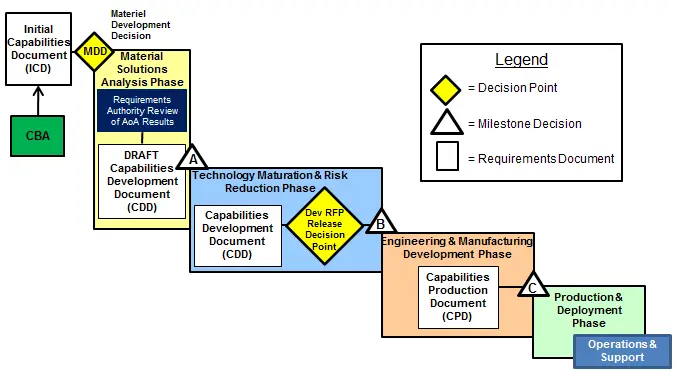The Capability Development Document (CDD) specifies the operational requirements for the system that will deliver the capability that meets the operational performance criteria specified in the Initial Capabilities Document (ICD). It outlines militarily useful increments of capability with its own set of attributes and development performance values (i.e., thresholds and objectives) in terms of Key Performance Parameters (KPP), Key System Attributes (KSAs), and Other System Attributes.
Definition: A Capability Development Document (CDD) specifies capability requirements in terms of developmental Key Performance Parameters (KPPs), Key System Attributes (KSAs), Additional Performance Attributes (APAs), and other related information necessary to support development of one or more increments of a materiel capability solution. It’s development of a specific materiel capability solution intended to wholly or partially satisfy validated capability requirements and close or mitigate associated capability gaps.
Capability Development Document (CDD) Development
The CDD is developed during the Technology Maturation & Risk Reduction (TD) Phase to guide the Engineering, Manufacturing & Development (EMD) Phase by defining measurable and testable capabilities. The CDD supports and must be validated and approved before the Milestone B (MS B) decision at the Development RFP Release Decision Point.

Figure: CDD in the Acquisition/JCIDS Process
Capability Development Document (CDD) per Capability Increment
The CDD is system-specific and applies to a single increment of capability in an Evolutionary Acquisition program. Each program increment will either have its own CDD or a separate annex on a master CDD.
Capability Development Document (CDD) Main References
What is in the Capability Development Document (CDD)
The CDD identifies the operational performance attributes of the proposed system. Key Performance Parameters (KPP) and Key System Attributes (KSA) are introduced in the CDD. The cost will be included in the CDD as Life-Cycle Cost (LCC) or, if available, Total Ownership Costs (TOC). The CDD also provides traceability to predecessor documents and previously validated capability requirements, provides supporting data for certifications and endorsements, identifies related DOTmLPF-P impacts of the proposed capability solution, and outlines projected life cycle costs resulting from pursuing the capability solution.
Capability Development Document (CDD) Required Sections [3]
The following sections must be addressed in the CDD according to the Manual for the Operations of the Joint Capabilities Integration and Development System (JCIDS).
- Operational Context
- Threat Summary
- Capability Discussion
- Program Summary
- Development KPPs, KSAs, and APAs
- Other System Attributes
- Spectrum Requirements
- Intelligence Supportability
- Weapon Safety Assurance
- Technology Readiness Assessment
- DOTMLPF-P Considerations
- Program Affordability
Capability Development Document (CDD) Regulatory Requirements
REGULATORY: A draft CDD is required at Milestone A; a validated CDD is required at the Development RFP Release Decision Point and informs Milestone B. If there are no changes, a revalidated CDD may be submitted for the Capability Production Document (CPD) required at Milestone C. [2]
Capability Development Document (CDD) Acquisition Milestone/Phase Approval Criteria
Throughout the Acquisition Process, certain milestones and events require a sponsored approved draft or validated Capability Development Document (CDD). These entrance criteria are:
- Draft CDD: Entrance criterion for the Request for Proposal (RFP) release in support of the TMRR Phase
- Draft CDD: Milestone A decision.
- Validated CDD: Development RFP Release Decision Point.
- Validated CDD: Milestone B decision.
- Validated CDD: Prior to EMD Phase when Milestone B is not required.
Capability Development Document (CDD) with Regard to Test & Evaluation
As the CDD is going through the Joint Requirements Oversight Council (JROC) approval process prior to Milestone B, the Test & Evaluation (T&E) Working-level Integrated Product Team (T&E WIPT) updates the T&E Strategy using the system-specific details in the CDD. The CDD provides the KPP and Key System Attributes (KSA) that provide a focus for the T&E program. The T&E strategy gains details (specific, desired, operational capabilities; T&E events (Developmental Test and Evaluation, Operational Test and Evaluation, and Live-Fire Test and Evaluation) adding to the broad, initial T&E Strategy; Critical Operational Issues (COI); refining the management structure and composition of the T&E WIPT; identifying resource requirements more precisely; etc.) that defines the scope and size of the planned T&E program, and permits a better estimate of the T&E resources and costs.
Capability Development Document (CDD) Development Tool
The Capability Development Tracking and Management (CDTM) tool is provided as a means to generate and submit ICDs, CDDs, CPDs, and Joint DCRs to the Knowledge Management/Decision Support (KM/DS) system.
Capability Development Document (CDD) Traceability
The CDD provides traceability to previously approved requirement documents, key performance parameters (KPP)/Key System Attributes (KSA), certifications and endorsements data, DOTmLPF-P analysis results and corresponding impacts, and life cycle costs estimates.
AcqNotes Tutorials
AcqTips:
- The CDD replaced the Operational Requirements Document (ORD) that was used under the old Requirements Generation System.
- The format for the CDD is found in Appendix A to Enclosure H of the Manual for the Operation of the Joint Capabilities Integration and Development System, updated July 2012
- Because the CDD normally is not approved until around the time of Milestone B, the T&E WIPT will most likely have to work from a draft version to prepare the Test and Evaluation Master Plan (TEMP) before the Milestone B decision. (See the JCIDS Manual)
AcqLinks and Resources:
- CJCS Instruction 5123.01 “Charter Joint Requirements Oversight Council (JROC) and Implementation of the Joint Capabilities Integration and Development System (JCIDS)”
- [1] CJCS Instruction 3170.01 “Joint Capabilities Integration and Development System”
- [2] DoD Instruction 5000.02 “Operation of the Defense Acquisition System”
- [3] Manual for the Operations of the Joint Capabilities Integration and Development System (JCIDS)
- Defense Acquisition Guidebook (DAG)
- CDD Writers Guide
- JCIDS Process Flow Chart
- Template: Capability Development Document (CDD) – 30 Oct 2012 (Outdated)
- Checklist: Air Force Draft CDD Checklist
Updated: 2/17/2024
Rank: G1.6
